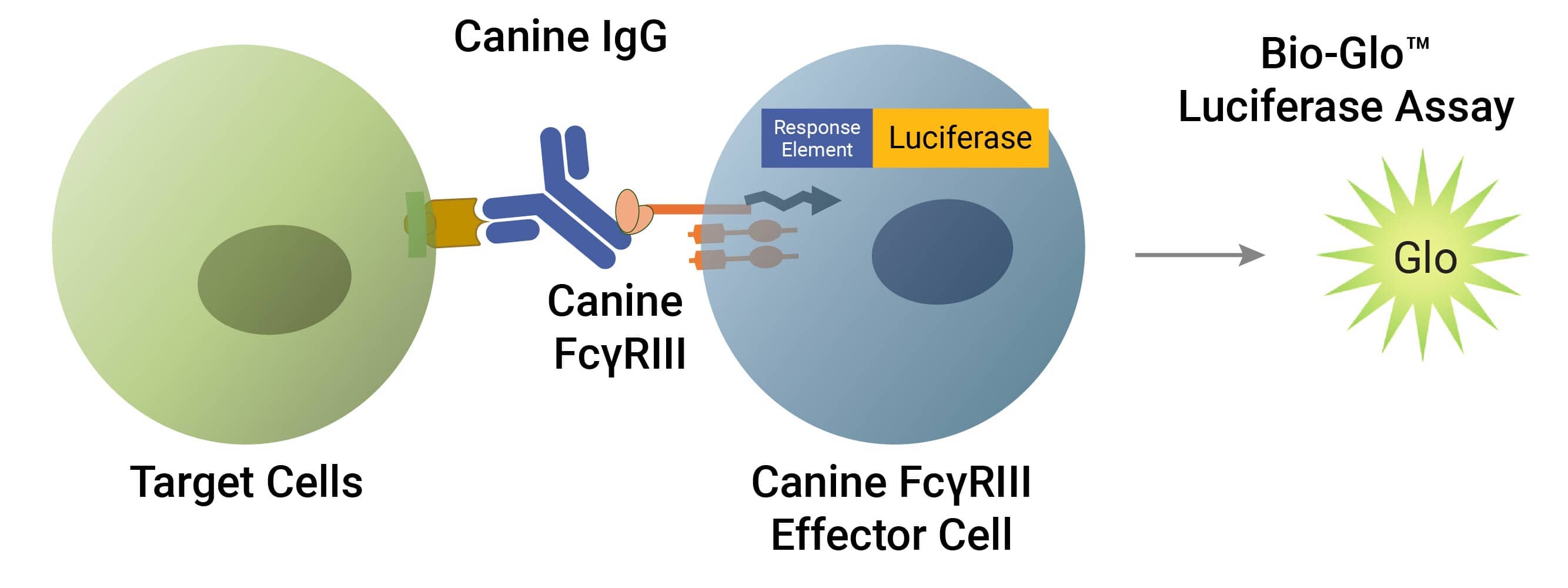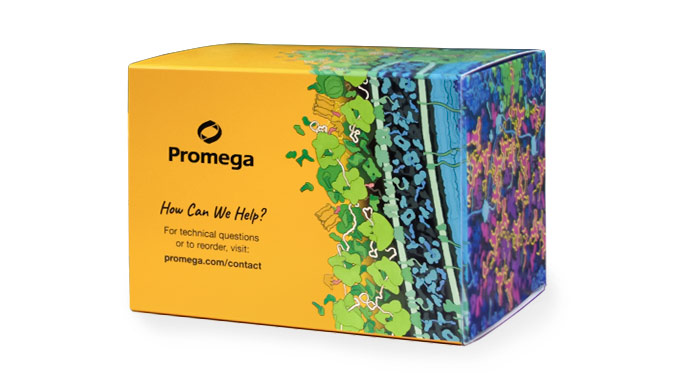Canine FcγRIII ADCC Bioassay
Canine FcγRIII ADCC Bioassay
| Catalog No. | Product Name | Size | Price | Qty | |||
|---|---|---|---|---|---|---|---|
| CS3631A05 | Early Access Canine FcγRIII ADCC Bioassay | View Specifications | 1 each | Consultar Precio | |||
| CS3631A07 | Early Access Canine FcγRIII ADCC Bioassay 5X | View Specifications | 1 each | Consultar Precio | |||
| CS3631A02 | Early Access Canine FcγRIII ADCC Reporter Bioassay, Propagation Model | View Specifications | 1 each | Consultar Precio |
Early Access = This product is available under our Early Access program - Learn More
Catalog (FT) = This product is available under our Catalog (FT) program - Learn More
Fetch the Most Reliable Data with the Canine FcγRIII ADCC Bioassay
Canine Antibody-Dependent Cell-Mediated Cytotoxicity (ADCC) is an immune-response mechanism in which antibodies bind to a target cell, such as a virus-infected or cancerous cell, and recruit natural killer (NK) cells for their cytotoxic effector functions. There are several challenges to measuring the ADCC activity of canine immunotherapeutics including lack of standard protocols, limited species-specific assays and high levels of variability in primary effector cells.
The Canine FcγRIII ADCC Bioassay is a simple and robust system that can be used to measure the ADCC activity of canine antibody drugs that bind canine FcγRIII. The assay consists of a stable reporter cell line that reduces the variability and challenges of isolating canine PBMCs for primary cell assays.
Demonstrate ADCC Activity Through the Canine FcγRIII Receptor

Principle of Canine FcγRIII ADCC Bioassay. The Canine FcγRIII ADCC Bioassay consists of two cell lines, the user-supplied target cells and the canine reporter cell. When co-cultured with canine IgG antibody, the FcγRIII receptor is activated and triggers promoter-driven luminescence that is detected and quantified using the Bio-Glo™ Reagent.
Assay Workflow: Standardized Reagents to Improve Your Results

- Thaw-and-use cell format provides significant time and labor savings over traditional methods while reducing variability.
- Kit includes all of the required reagents in standardized formats.
- Easily amenable to high-throughput workflows.
Assay Performance Data

Increasing concentrations of canonized rituximab (anti-human CD20 with canine IgG2 Fc) were incubated with Raji (CD20+) target cells and Canine FcγRIII ADCC Effector Cells. Bio-Glo™ Reagent was added and luminescence measured.
Interested in additional animal health bioassays?
Contact us to learn about our bioassay development services.
Protocols
No protocols available
Specifications
Catalog Number:
Contenido
| Item | Part # | Presentación |
|---|---|---|
Canine FcγRIII Effector Cells |
CS3631A03 | 1 × 0.5ml |
RPMI 1640 Medium |
G708A | 1 × 36ml |
Low IgG Serum |
G711A | 1 × 4ml |
Bio-Glo™ Luciferase Assay Buffer |
G719A | 1 × 10ml |
Bio-Glo™ Luciferase Assay Substrate |
G720A | 1 × 1 vial |
SDS
Search for SDSCertificado de Análisis
Promega Cell Line Limited Use Label License (LULL)
BY USE OF THIS MATERIAL, RECIPIENT AGREES TO BE BOUND BY THE TERMS OF THIS LIMITED USE LABEL LICENSE.
-
1. Usage and Transfer Restrictions:
- 1.1. Recipient may use this material for research use only, which includes but is not limited to drug discovery and development, quality assurance testing and product release assays. No transfer, resale or commercial use of this material is allowed without the written consent of Promega Corporation.
- 1.2. “Commercial use” means any and all uses of this material or derivatives by recipient for monetary or other consideration, including product manufacture, providing a service, information or data to unaffiliated third parties and resale of the material for any use.
-
2. Modification Restrictions:
- 2.1. Recipient shall have no right to modify, derivatize or otherwise create variations of the nucleotide sequence of any proprietary gene, including but not limited to luciferase, NanoBiT® technology (e.g., HiBiT), HaloTag® technology or genes stably transfected within the cells.
- 2.2. Recipient shall have no right to genetically engineer or otherwise modify the cell line.
-
3. Propagation and Storage:
- 3.1. The recipient may not propagate the cells, unless material is marked as Propagation Model, Cell Bank or Master Cell Bank; then recipient may propagate and store the cells for long-term use.
-
4. For all determinations of luminescence or other assay-related activity of this material and its derivatives, recipient must either:
- 4.1. Use the detection systems specified in the protocol or data report and purchased from Promega for all luminescence assays when using this material; or
- 4.2. Contact Promega to obtain a license for use of this material with reagents other than a Bio-Glo™ branded luciferase reagent, including but not limited to:
- 4.2.1 Bio-Glo™, Bio-Glo-NL™, Bio-Glo-NB™ TCK, Bio-Glo-NB™ VLP, Bio-Glo-NB™ Lytic
-
5. For uses of this material for energy transfer (such as bioluminescence resonance energy transfer), recipient must:
- 5.1. Use NanoBRET™-branded luminescent assay reagents (LARs; e.g., NanoBRET™ Nano-Glo® Substrate), Intracellular TE Nano-Glo® Substrate/Inhibitor or Intracellular TE Nano-Glo® Vivazine™/Inhibitor for all determinations of luminescent activity by this material and its derivatives; and
- 5.2. Use NanoBRET™-branded energy acceptors (e.g., NanoBRET™ tracers, NanoBRET™ dyes, BRET-optimized HaloTag® ligands) for all determinations of energy transfer activity by this material and its derivatives; or
- 5.3. Contact Promega to obtain a license for the use of the material and its derivatives for energy transfer assays to energy acceptors not manufactured by Promega. No license is needed if the energy transfer acceptor is a genetically encoded autofluorescent protein.
-
6. For uses of HaloTag® Technology in this material, recipient must either:
- 6.1. Use Promega HaloTag® ligands, which can be modified or linked to Promega or customer-supplied moieties; or
- 6.2. Contact Promega to obtain a license if Promega HaloTag® ligands are not to be used.
-
7. Disclaimer and Governing Law:
- 7.1. PROMEGA MAKES NO REPRESENTATIONS OR WARRANTIES OF ANY KIND, EITHER EXPRESSED OR IMPLIED, INCLUDING FOR MERCHANTABILITY OR FITNESS FOR A PARTICULAR PURPOSE, WITH REGARD TO THE MATERIAL. The terms of this label license shall be governed under the laws of the State of Wisconsin, USA.
Contenido
| Item | Part # | Presentación |
|---|---|---|
Canine FcγRIII Effector Cells |
CS3631A03 | 5 × 0.5ml |
RPMI 1640 Medium |
G708A | 5 × 36ml |
Low IgG Serum |
G711A | 5 × 4ml |
Bio-Glo™ Luciferase Assay Buffer |
G719A | 5 × 10ml |
Bio-Glo™ Luciferase Assay Substrate |
G720A | 5 × 1 vial |
SDS
Search for SDSCertificado de Análisis
Promega Cell Line Limited Use Label License (LULL)
BY USE OF THIS MATERIAL, RECIPIENT AGREES TO BE BOUND BY THE TERMS OF THIS LIMITED USE LABEL LICENSE.
-
1. Usage and Transfer Restrictions:
- 1.1. Recipient may use this material for research use only, which includes but is not limited to drug discovery and development, quality assurance testing and product release assays. No transfer, resale or commercial use of this material is allowed without the written consent of Promega Corporation.
- 1.2. “Commercial use” means any and all uses of this material or derivatives by recipient for monetary or other consideration, including product manufacture, providing a service, information or data to unaffiliated third parties and resale of the material for any use.
-
2. Modification Restrictions:
- 2.1. Recipient shall have no right to modify, derivatize or otherwise create variations of the nucleotide sequence of any proprietary gene, including but not limited to luciferase, NanoBiT® technology (e.g., HiBiT), HaloTag® technology or genes stably transfected within the cells.
- 2.2. Recipient shall have no right to genetically engineer or otherwise modify the cell line.
-
3. Propagation and Storage:
- 3.1. The recipient may not propagate the cells, unless material is marked as Propagation Model, Cell Bank or Master Cell Bank; then recipient may propagate and store the cells for long-term use.
-
4. For all determinations of luminescence or other assay-related activity of this material and its derivatives, recipient must either:
- 4.1. Use the detection systems specified in the protocol or data report and purchased from Promega for all luminescence assays when using this material; or
- 4.2. Contact Promega to obtain a license for use of this material with reagents other than a Bio-Glo™ branded luciferase reagent, including but not limited to:
- 4.2.1 Bio-Glo™, Bio-Glo-NL™, Bio-Glo-NB™ TCK, Bio-Glo-NB™ VLP, Bio-Glo-NB™ Lytic
-
5. For uses of this material for energy transfer (such as bioluminescence resonance energy transfer), recipient must:
- 5.1. Use NanoBRET™-branded luminescent assay reagents (LARs; e.g., NanoBRET™ Nano-Glo® Substrate), Intracellular TE Nano-Glo® Substrate/Inhibitor or Intracellular TE Nano-Glo® Vivazine™/Inhibitor for all determinations of luminescent activity by this material and its derivatives; and
- 5.2. Use NanoBRET™-branded energy acceptors (e.g., NanoBRET™ tracers, NanoBRET™ dyes, BRET-optimized HaloTag® ligands) for all determinations of energy transfer activity by this material and its derivatives; or
- 5.3. Contact Promega to obtain a license for the use of the material and its derivatives for energy transfer assays to energy acceptors not manufactured by Promega. No license is needed if the energy transfer acceptor is a genetically encoded autofluorescent protein.
-
6. For uses of HaloTag® Technology in this material, recipient must either:
- 6.1. Use Promega HaloTag® ligands, which can be modified or linked to Promega or customer-supplied moieties; or
- 6.2. Contact Promega to obtain a license if Promega HaloTag® ligands are not to be used.
-
7. Disclaimer and Governing Law:
- 7.1. PROMEGA MAKES NO REPRESENTATIONS OR WARRANTIES OF ANY KIND, EITHER EXPRESSED OR IMPLIED, INCLUDING FOR MERCHANTABILITY OR FITNESS FOR A PARTICULAR PURPOSE, WITH REGARD TO THE MATERIAL. The terms of this label license shall be governed under the laws of the State of Wisconsin, USA.
Contenido
| Item | Part # | Presentación |
|---|---|---|
Canine FcγRIII Effector Cells (CPM) |
CS3631A01 | 2 × 1ml |
Promega Cell Line Limited Use Label License (LULL)
BY USE OF THIS MATERIAL, RECIPIENT AGREES TO BE BOUND BY THE TERMS OF THIS LIMITED USE LABEL LICENSE.
-
1. Usage and Transfer Restrictions:
- 1.1. Recipient may use this material for research use only, which includes but is not limited to drug discovery and development, quality assurance testing and product release assays. No transfer, resale or commercial use of this material is allowed without the written consent of Promega Corporation.
- 1.2. “Commercial use” means any and all uses of this material or derivatives by recipient for monetary or other consideration, including product manufacture, providing a service, information or data to unaffiliated third parties and resale of the material for any use.
-
2. Modification Restrictions:
- 2.1. Recipient shall have no right to modify, derivatize or otherwise create variations of the nucleotide sequence of any proprietary gene, including but not limited to luciferase, NanoBiT® technology (e.g., HiBiT), HaloTag® technology or genes stably transfected within the cells.
- 2.2. Recipient shall have no right to genetically engineer or otherwise modify the cell line.
-
3. Propagation and Storage:
- 3.1. The recipient may not propagate the cells, unless material is marked as Propagation Model, Cell Bank or Master Cell Bank; then recipient may propagate and store the cells for long-term use.
-
4. For all determinations of luminescence or other assay-related activity of this material and its derivatives, recipient must either:
- 4.1. Use the detection systems specified in the protocol or data report and purchased from Promega for all luminescence assays when using this material; or
- 4.2. Contact Promega to obtain a license for use of this material with reagents other than a Bio-Glo™ branded luciferase reagent, including but not limited to:
- 4.2.1 Bio-Glo™, Bio-Glo-NL™, Bio-Glo-NB™ TCK, Bio-Glo-NB™ VLP, Bio-Glo-NB™ Lytic
-
5. For uses of this material for energy transfer (such as bioluminescence resonance energy transfer), recipient must:
- 5.1. Use NanoBRET™-branded luminescent assay reagents (LARs; e.g., NanoBRET™ Nano-Glo® Substrate), Intracellular TE Nano-Glo® Substrate/Inhibitor or Intracellular TE Nano-Glo® Vivazine™/Inhibitor for all determinations of luminescent activity by this material and its derivatives; and
- 5.2. Use NanoBRET™-branded energy acceptors (e.g., NanoBRET™ tracers, NanoBRET™ dyes, BRET-optimized HaloTag® ligands) for all determinations of energy transfer activity by this material and its derivatives; or
- 5.3. Contact Promega to obtain a license for the use of the material and its derivatives for energy transfer assays to energy acceptors not manufactured by Promega. No license is needed if the energy transfer acceptor is a genetically encoded autofluorescent protein.
-
6. For uses of HaloTag® Technology in this material, recipient must either:
- 6.1. Use Promega HaloTag® ligands, which can be modified or linked to Promega or customer-supplied moieties; or
- 6.2. Contact Promega to obtain a license if Promega HaloTag® ligands are not to be used.
-
7. Disclaimer and Governing Law:
- 7.1. PROMEGA MAKES NO REPRESENTATIONS OR WARRANTIES OF ANY KIND, EITHER EXPRESSED OR IMPLIED, INCLUDING FOR MERCHANTABILITY OR FITNESS FOR A PARTICULAR PURPOSE, WITH REGARD TO THE MATERIAL. The terms of this label license shall be governed under the laws of the State of Wisconsin, USA.
Resources
Featured Resource
Webinar: Innovative ADCC and ADCP Technologies and Services for Cell Therapies and Therapeutic Antibodies
The rising demand for cell therapies and therapeutic antibodies calls for innovative development technologies. A major challenge is the analysis of antibody-dependent cell-mediated cytotoxicity (ADCC) and phagocytosis (ADCP), critical for therapeutic antibody effectiveness. Traditional ADCC and ADCP methods, dependent on primary cells, are laborious and highly variable, impeding drug development.

Related Products
Productos Similares
Canine PD-1/PD-L1 Blockade Bioassay
Cell-based reporter system to measure potency and stability of biologics designed to block canine PD-1/PD-L1 interaction.
CS348807, CS348809, CS348803, CS348811
ADCC Reporter Bioassay, V Variant
Measure potency and stability of antibodies mediating ADCC through the high-affinity human FcγRIIIa-V receptor.
G7015, G7014, G7010, G7016, G7013, G7018, G7102, GA1130
Mouse FcγRIV ADCC Bioassay
Characterize the Fc effector activity of antibodies that bind and activate the mouse mFcγRIV receptor.
M1201, M1211, M1215, M1212
FcγRI ADCP Bioassay
Measure the potency and stability of antibodies and other biologics with Fc domains that bind and activate FcγRI.
GA1341, GA1345, GA1332, GA1330
Usado con frecuencia junto con
GloMax® Discover System
Lector de microplacas de alto rendimiento para la detección de luminiscencia, fluorescencia y absorbancia.
GM3000
PD-1/PD-L1 Blockade Bioassay
Measure the ability of biologics to block immune checkpoint signals
J1250, J1255, J1252, J1191, J1195, J1201
TLR Reporter Bioassay
Measure the potency and stability of TLR agonists.
JA9011, JA9015, GA1322, GA6010
IL-6 Bioassay
Ensayo para medir la potencia y la estabilidad de los productos biológicos diseñados para activar o inhibir la interacción de la IL-6 y el IL-6R.
J2992, JA2501, JA2505



